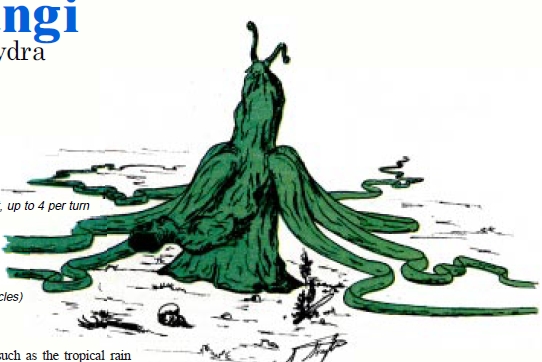

FREQUENCY: rare
NUMBER APPEARING: 1
ARMOR CLASS: 5
MOVE: ¼”
HIT DICE 7-9
% IN LAIR: 100%
TREASURE TYPE: special
NUMBER OF ATTACKS: 2 tentacles per
DAMAGE/ATTACK: 2-8 (constriction)
SPECIAL ATTACKS: bite
MAGICAL DEFENSES: standard
INTELLIGENCE: animal
ALIGNMENT: neutral
SIZE: L (6-10 feet tall; with eight 20'-40' tentacles)
LEVEL/XP VALUE:
The ukuyatangi inhabits hot, wet, forests such as the tropical rain
forests of Africa and South America. The creature usually situates
itself
in a large, flat area of the forest, its main trunk in a small clearing,
with its
eight tentacles spread out through the trees and undergrowth of the
surrounding forest.
The ukuyatangi bears some resemblance to its microscopic cousin,
the hydra. It has a tough, leathery hide of mottled green and brown
coloration. The central trunk stands erect, about six to ten feet high,
and is topped with an extendable tube-like mouth two or three feet
in
diameter. The tentacles extend from the edges of the mouth in all
directions, blending into the trees and undergrowth of the forest.
Two
long eyestalks permit the ukuyatangi 360° vision within the confines
of
the clearing; however, it is somewhat nearsighted and cannot see well
into the forested areas.
The ukuyatangi is capable of limited movement, which is accomplished
by dint of pure strength—the creature hoists itself up on its
tentacles and slides its trunk along, a yard or two at a time. Generally,
a
ukuyatangi moves only if it needs to find a new feeding location. The
creature does not hunt per se: instead it waits until a victim brushes
up
against one of its tentacles. The tentacles, which are enormously strong,
seize the victim and drag him to the clearing. Even large creatures
can
be devoured, as the ukuyatangi constricts the body of the victim for
several minutes until it is sufficiently pulpy to permit the ukuyatangi
to
squeeze it into its mouth tube to be devoured. (The tentacles of the
creature can be imagined as long, constrictor-type snakes).
Once the ukuyatangi has devoured the equivalent of two mansized
creatures it will not immediately try to consume others, although it
will certainly kill off any other available creatures for later consumption.
A ukuyatangi will normally consume only one man-sized creature each
day, or an equivalent number of smaller creatures.
Due to the creature’s excellent camouflage, there is a 90% chance
for each person in a party to accidentally touch a tentacle. The touched
tentacle will immediately try to grasp the person who touched it, and
other nearby tentacles will move in to assist. If these tentacles are
touched, they too will try to grab those they touch. The tentacles
are
sensitive only to warmblooded creatures, and will not attempt to grasp
if poked at with branches, etc. If seriously damaged, tentacles will
retract toward the central trunk. If no tentacles are touched, an exploring
party may move close enough to see the clearing and the creature’s
central trunk.
The ukuyatangi regurgitates any undigestible material, and the
clearing will be littered with bones, weapons, armor, etc. of any former
victims. Remember, the creature has eystalks that can see in the
clearing, and any of the party venturing into the clearing will be
detected and the ukuyatangi will pull in its tentacles and attempt
to
snare whatever it can see.
While a ukuyatangi will normally consume only one man-sized
creature each day, or an equivalent number of smaller creatures, if
the
food supply is plentiful it will consume up to two man-sized creatures
per day. Any other creatures venturing into its reach will be snared
by
the tentacles and constricted to death, but not consumed.
The ukuyatangi is reptilian in nature, and is therefore susceptible
to
cold. If the temperature of the air should drop below 10° C, the
creature
will coil its tentacles about its trunk and will remain dormant until
the
temperature rises again. All forms of cold attack do double damage
to a
ukuyatangi. The ukuyatangi’s dexterity is to be considered to be 16
at
20° C or higher, with a decrease of one dexterity point for each
degree
drop in temperature.
| Dragon magazine | MM | - | - | 1st Edition AD&D |